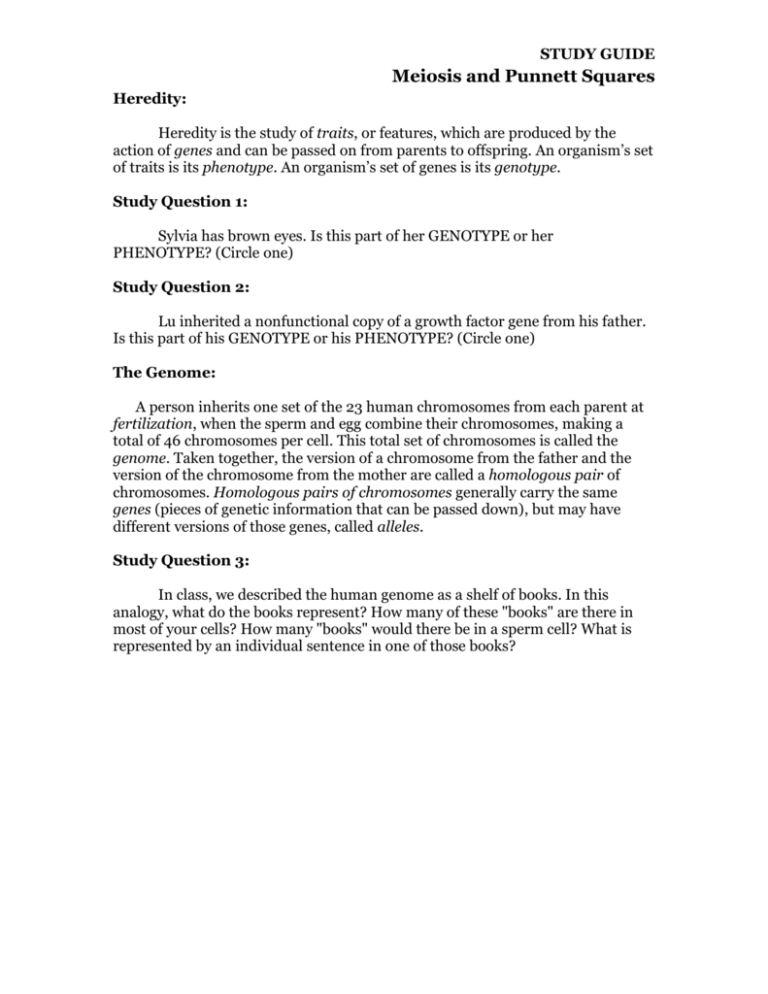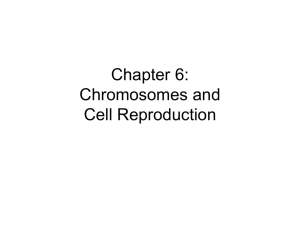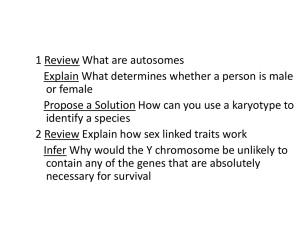Word Document
advertisement

STUDY GUIDE Meiosis and Punnett Squares Heredity: Heredity is the study of traits, or features, which are produced by the action of genes and can be passed on from parents to offspring. An organism’s set of traits is its phenotype. An organism’s set of genes is its genotype. Study Question 1: Sylvia has brown eyes. Is this part of her GENOTYPE or her PHENOTYPE? (Circle one) Study Question 2: Lu inherited a nonfunctional copy of a growth factor gene from his father. Is this part of his GENOTYPE or his PHENOTYPE? (Circle one) The Genome: A person inherits one set of the 23 human chromosomes from each parent at fertilization, when the sperm and egg combine their chromosomes, making a total of 46 chromosomes per cell. This total set of chromosomes is called the genome. Taken together, the version of a chromosome from the father and the version of the chromosome from the mother are called a homologous pair of chromosomes. Homologous pairs of chromosomes generally carry the same genes (pieces of genetic information that can be passed down), but may have different versions of those genes, called alleles. Study Question 3: In class, we described the human genome as a shelf of books. In this analogy, what do the books represent? How many of these "books" are there in most of your cells? How many "books" would there be in a sperm cell? What is represented by an individual sentence in one of those books? STUDY GUIDE Meiosis and Punnett Squares Meiosis: Like mitosis, meiosis is a form of eukaryotic cell division. Unlike mitosis, meiosis is when when a single eukaryotic cell divides into four daughter cells with half the number of chromosomes that the original cell had. These daughter cells are called gametes, or sex cells, and become the sperm or egg. During meiosis I, the first division, the homologous pairs of chromosomes separate. This results in two daughter cells, each with 23 chromosomes. Each of these chromosomes is from either the mother's set or the father's set; both possibilities are equally likely. During meiosis II, the sister chromatids of these 23 chromosomes separate and the two daughter cells divide again, resulting in a total of four cells at the end of meiosis. Study Question 4: Suppose a certain plant has 6 chromosomes, 3 from each parent. Draw one of its cells in interphase before meiosis, the two daughter cells produced after meiosis I, and the four daughter cells produced after meiosis II. Show chromosomes clearly. Fertilization and Punnett Squares: Since a sperm cell and an egg cell each have 23 chromosomes, when they combine, the resulting cell has 46 chromosomes. This is fertilization. Suppose that the ability to taste a bitter chemical is controlled by a gene with two alleles, T and t. People with at least one T allele can taste this chemical. If, upon fertilization, an egg contributes a chromosome carrying the T allele and a sperm contributes a chromosome carrying the t allele, the resulting offspring will have both alleles and the genotype Tt. They would be able to taste the chemical. To visualize the possible combinations of sperm, egg, and offspring genotypes, we use a Punnett Square. Punnett squares are shown in your text in chapter 9, but we will practice them here. The steps to making a Punnett square are as follows: 1. Labeling the rows and columns: Figure out what sperm and eggs the parents might produce. For example, if the father has chromosomes with T and t STUDY GUIDE Meiosis and Punnett Squares alleles, he could make sperm carrying either of those alleles. Label the columns and rows with the sperm and egg genotypes. Example: Mating of woman with genotype TT and man with genotype Tt: Possible Sperm T t Possible Eggs T T If multiple chromosomes are involved, the problem is more complicated. Suppose we're discussing two genes. One controls whether or not a person can roll their tongue (alleles R and r). The other is the gene for tasting the bitter chemical (alleles T and t). What if we have a man with genotype RrTt and a woman with the genotype Rrtt? Because meiosis produces daughter cells with only one version of each chromosome, the man cannot pass down Tt sperm. His sperm must have either the T allele or the t allele. This is called the law of segregation. The same goes for the R and r alleles. So there are four genotypes of sperm the man can make: RT, Rt, rT, and rt. There is a 50/50 chance of passing down allele R, and a 50% chance of passing down r. This chance is independent of the chance of passing down T or t, since they're on separate chromosomes. This is called the law of independent assortment. What are the two possible egg genotypes the woman can make here? Make a guess before reading on. Remember that she can pass down R or r, but always passes down t, since her genotype is Rrtt. She doesn't have a T allele to pass. Here are the rows and columns for a Punnett square for this mating: RT Possible Sperm Rt rT rt Possible Eggs Rt Rt rt rt (Note: When there are fewer possible egg/sperm for one parent than the other, we repeat the genotypes to fill space. Here, we list each possible egg twice (Rt, Rt, rt, rt), since there are 2 possibilities for the mother, but 4 for the father.) Study Question 5: Would the law of independent assortment still apply here if the R and T genes were on the same chromosome? Why or why not? STUDY GUIDE Meiosis and Punnett Squares 2. Fertilizing eggs with sperm: To simulate fertilization, combine the egg and sperm genotypes to create offspring. For example, if a square is in a row labeled with the genotype Ab, and a column with the genotype ab, the resulting child would have the genotype Aabb; it would inherit a chromosome with the A allele from the egg, a homologous chromosome with the a allele from the sperm, a chromosome with the b allele from the egg, and a chromosome with the b allele from the sperm. Note that we keep alleles on homologous chromosomes paired up together. We write Aabb, not Abab. Study Question 6: Let's try this. Here's the first mating, with the genotypes from two fertilizations (offspring) filled in. Fill in the other two offspring genotypes. Possible Sperm T t Possible Eggs T T Tt TT Study Question 7: Now we'll try the second mating. Some squares are filled in for you: RT Possible Eggs Rt Rt rt rt Possible Sperm Rt rT rt RRtt rrTt RrTt rrtt Dominant and Recessive Alleles/Traits: If a person inherits the same allele of a gene from both parents, that person is homozygous at that gene1. If a person inherits one allele from their father and a different allele from their mother, they are heterozygous. For example, if a person inherits a T from their mother and a t allele from their father, they are Tt heterozygous. If, on the other hand, they inherit two t alleles, they are tt homozygous. A trait is recessive if it requires two copies of a certain allele in order to be expressed. In other words, one cannot express the trait unless one is homozygous 1 Technically, a geneticist would say a person is homozygous at that locus, or location on the chromosome. But we won’t go into too much detail there. STUDY GUIDE Meiosis and Punnett Squares for the allele. Being unable to taste the bitter chemical is a recessive trait; you need two copies of the t allele to be unable to taste it. If you have even one T allele, you can taste it. This means that being able to taste the chemical is a dominant trait. A trait is dominant if you only need one copy of an allele in order to express that trait. The dominant allele is the allele that leads to the dominant trait (in this case, T). The recessive allele is the allele that leads to the recessive trait (in this case, t). There are further subtleties of definition, but I will ignore them. Study Question 7: Three siblings have the following genotypes and phenotypes for the “tonguerolling” gene: Genotype Phenotype Alice: Rr Can roll tongue Bob: rr Can’t roll tongue Carol: RR Can roll tongue Is being able to roll your tongue a DOMINANT or a RECESSIVE trait? Is being unable to roll your tongue a DOMINANT or a RECESSIVE trait? Study Question 8: Go back to the Punnett square you completed for the second mating (the 4x4 square). What fraction of the possible offspring have the following phenotypes? (You made 16 possibilities, so the answer should be a fraction out of 16). I've given you two examples to start with: Phenotype Can roll tongue, can taste bitter chemical Can roll tongue, can't taste bitter chemical Can't roll tongue, can taste bitter chemical Can't roll tongue, can't taste bitter chemical Fraction of Possible Offspring 6/16 2/16 In other words, the probability of a child from this mating having the ability to both roll their tongue and taste the chemical is 6/16 = 37.5%, and so on. This does not mean that if the couple somehow bore 16 children, 6 would have both abilities. The Punnett square gives us probabilities, not the number of fertilization events that actually occur!









